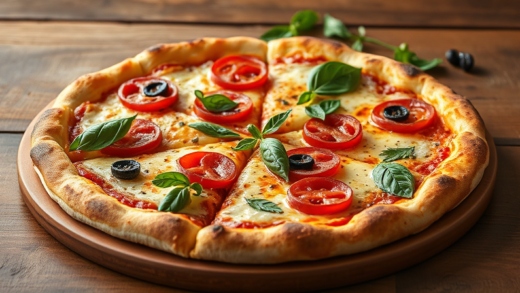Introduction
Pizza is a beloved dish enjoyed by many around the world, but achieving the perfect homemade pizza can be a challenging task. From the dough to the toppings to the baking process, there are common mistakes that can hinder the success of your pizza-making endeavors. In this article, we will explore some of the most common pizza mistakes and provide valuable insights on how to avoid them. By understanding these pitfalls and learning how to overcome them, you can elevate your pizza-making skills and create delectable pies that rival your favorite pizzeria.
1. Choosing the Wrong Dough
Understanding Different Types of Pizza Dough
Pizza dough isn’t just flour and water – there are various types like Neapolitan, New York-style, and even gluten-free options. Each one has its unique characteristics, so choose wisely!
Matching Dough to Desired Crust Texture
Love a crispy crust? Go for a thin dough. Craving a chewy texture? Opt for a dough with a higher protein content. Make sure your dough aligns with the crust texture you’re aiming for.
—
2. Overloading with Toppings
Striking the Right Balance of Toppings
Sure, loading up on toppings seems fun, but too much can weigh down your pizza and make it soggy. Strike a balance between flavors without overwhelming your base.
How Too Many Toppings Affect Baking
Excessive toppings can create a soggy mess in the middle of your pizza, leaving you with disappointment instead of delight. Don’t let your enthusiasm for toppings ruin your baking experience.
—
3. Incorrect Baking Temperature
Optimal Baking Temperatures for Different Crusts
The ideal baking temperature varies based on the type of crust you desire. High heat for a quick, crispy crust, and lower heat for a slower, more chewy texture. Don’t let the wrong temperature cramp your crust style!
Effects of High or Low Temperatures on Pizza Quality
Baking at extreme temperatures can make or break your pizza. Too hot, and you risk burning the crust before the toppings cook. Too low, and you’ll end up with a sad, undercooked mess. Find the sweet spot for your perfect pie.
—
4. Neglecting the Cheese
Choosing the Right Cheese for Your Pizza
Not all cheeses are created equal when it comes to pizza. Some melt beautifully, while others may turn into a rubbery disaster. Pick a cheese that complements your toppings and enhances your pizza experience.
Proper Cheese Distribution for Even Melting
Ever had a slice with a cheese-less crater in the middle? Uneven cheese distribution is a tragic pizza faux pas. Spread your cheese evenly to ensure every bite is gooey and delightful. Don’t let cheese neglect ruin your pizza party!
5. Skimping on Quality Ingredients**
**Importance of Using Fresh and Quality Ingredients:** Pizza is a simple dish that relies on a few key ingredients for its deliciousness. Using fresh and high-quality ingredients can make a world of difference in the final product. Opt for ripe tomatoes for the sauce, real mozzarella cheese, and fresh herbs for toppings to elevate your pizza game.
How Quality Ingredients Enhance Flavor:
Fresh ingredients pack a punch of flavor that can’t be replicated by their inferior counterparts. The vibrancy of fresh tomatoes in the sauce, the creaminess of real mozzarella, and the aroma of freshly picked herbs all work together to create a pizza that bursts with flavor in every bite. Don’t skimp on quality ingredients; your taste buds will thank you.
6. Improperly Preparing the Sauce
Key Elements of a Good Pizza Sauce:
A good pizza sauce should strike a balance between tangy, sweet, and savory flavors. Make sure to use ripe tomatoes, garlic, olive oil, and a touch of herbs like basil and oregano for a classic and delicious sauce. Simmer the sauce slowly to allow the flavors to meld together perfectly.
Tips for Properly Seasoning and Mixing Pizza Sauce:
When preparing your pizza sauce, taste as you go to adjust the seasonings accordingly. A pinch of salt, a dash of sugar to balance acidity, and a sprinkle of red pepper flakes for heat can take your sauce from ordinary to extraordinary. Don’t forget to mix well to ensure all the flavors are evenly distributed.
7. Not Allowing for Proper Resting Time
Why Resting Dough is Essential for Pizza Making:
Allowing your pizza dough to rest is crucial for gluten development, which affects the texture and structure of your crust. Resting the dough also gives the yeast time to ferment, adding complexity to the flavor profile of your pizza. Patience is key when it comes to creating the perfect pizza crust.
Optimal Resting Times for Dough Before Baking:
Depending on the recipe, dough usually needs to rest anywhere from a few hours to overnight in the refrigerator. This resting period allows the dough to relax and makes it easier to shape and stretch. For a light and airy crust, give your dough the time it needs to develop its full potential before baking.
Closing Thoughts
Mastering the art of making pizza at home is a rewarding journey that requires practice, patience, and attention to detail. By being mindful of common mistakes such as choosing the right dough, balancing toppings, and baking temperatures, you can significantly improve the quality of your homemade pizzas. Remember, each mistake is an opportunity to learn and refine your skills. With the tips provided in this article, you are well-equipped to create delicious pizzas that will impress your family and friends. So roll up your sleeves, preheat the oven, and enjoy the process of crafting your perfect homemade pizza masterpiece.




